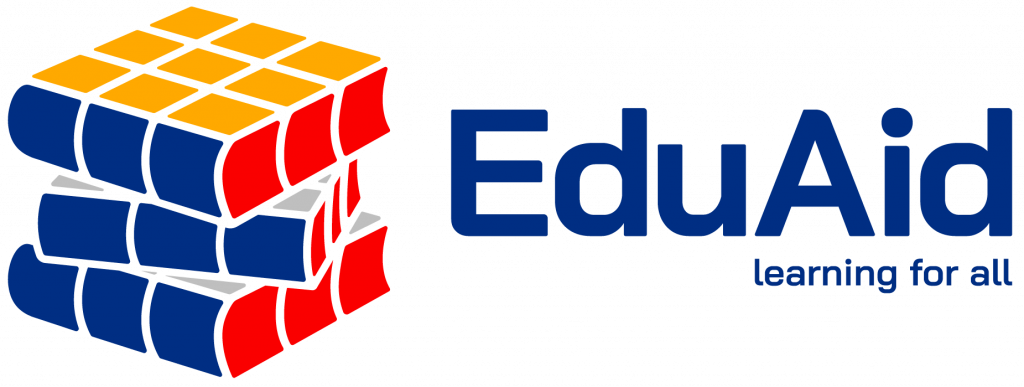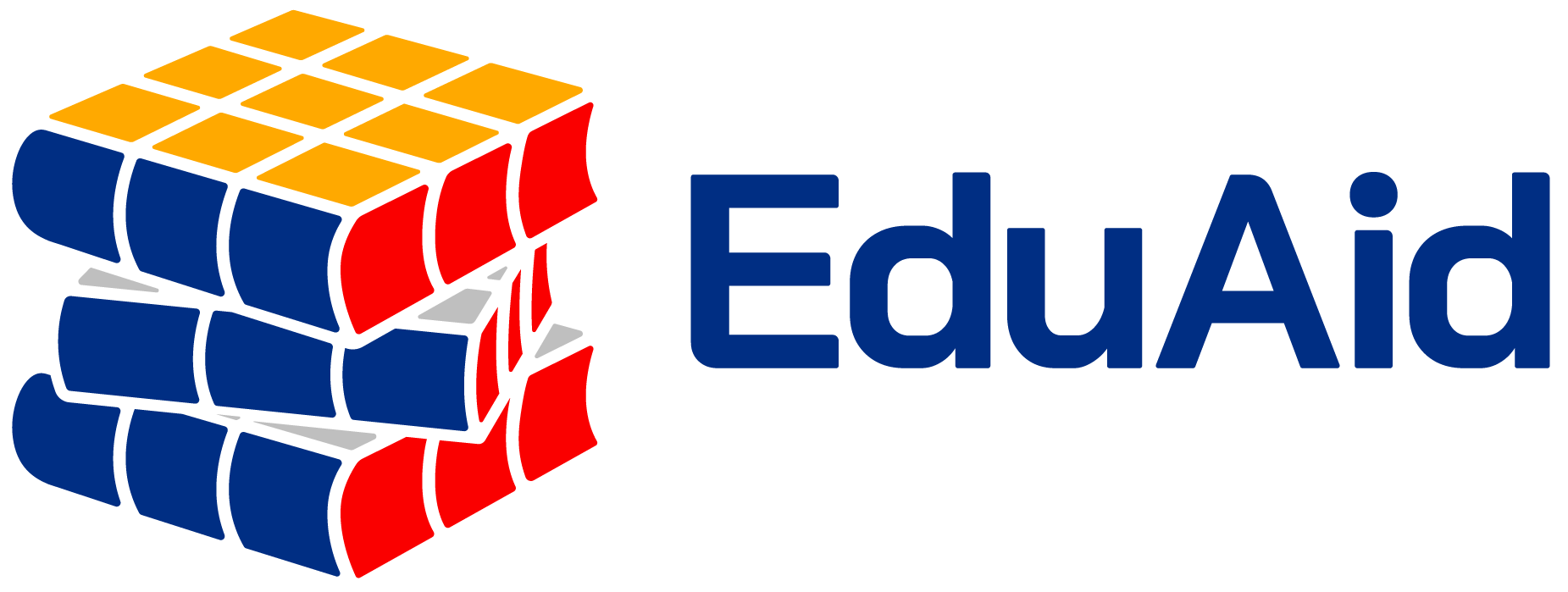NCERT Solutions for Maths Class 10 Chapter 7
Exercise 7.1
Question 1: Find the distance between the following pairs of points:
(i) (2, 3), (4, 1)
(ii) (-5, 7), (-1, 3)
(iii) (a, b), (-a, -b)
Answer:
(i) Distance between the two points is given by
\(\sqrt {(x_1-x_2)^2+(y_1-y_2)^2}\)
Therefore, dustance between (2, 3) and (4, 1) is given by
\(l=\sqrt{(2-4)^2+(3-1)^2=\sqrt{(-2)^2+(2)^2}}\)
\(=\sqrt{4+4}=\sqrt8=2\sqrt2\)
(ii) Distance between (\(-5,7)\) and \((-1,3)\) is given by
\(l=\sqrt{(-5-(-1))^2+(7-3)^2}=\sqrt{(-4)^2+(4)^2}\)
\(=\sqrt{16+16}=\sqrt{32}=4\sqrt2\)
(iii) Distance between \((a,b))\) and \((-1,-b)\) is given by
\(l=\sqrt{(a-(-a))^2+(b-(-b))^2}\)
\(=\sqrt{(2a)^2+(2b)^2}=\sqrt{4a^2+4b^2}=2\sqrt{a^2+b^2}\)
Question 2: Find the distance between the points \((0, 0)\) and \((36, 15)\). Can you dinf the distance between the two twons A and B discussed in Section \(7.2\).
Answer: Distance between points (0, 0) and (36, 15)
\(=\sqrt{(36-0^2+(5-2)^2}=\sqrt5\)
\(=\sqrt{(36-0)^2+(15+0)^2}=\sqrt{36^2+15^2}\)
\(=\sqrt{1296+225}=\sqrt{1521}=39\)
Yes we can find the distance between the given towns \(A\) and \(B\).
Assume town \(A\) at origin point \((0, 0)\).
Therefore, town B will be at point \((26, 15)\) with respect to town \(A\).
And hence, as calculated above, the distance between town \(A\) and \(B\) will be \(39\) km.
Question 3: Determine if the points \((1, 5),\space (2, 3)\) and \((− 2, − 11)\) are collinear.
Answer: Let the points \((1, 5),\space (2, 3)\) and \((−2, −11)\) be representing the vertices \(A,\space B\) and \(C\) of the given triangle respectively.
Let \(A=(1,5),B=(2,3),C(-2,-11)\)
\(BC=\sqrt{(2-(2))^2+3-(-11))^2}=\sqrt{4^2+14^2}=\sqrt{16+196}=\sqrt{212}\)
\(CA=\sqrt{1-(-2))^2+(5-(1-11))^2}\sqrt{3^2+16^2}=\sqrt{9+256}=\sqrt{265}\)
Since \(AB+BC\ne CA\)
Therefore, the points \((1, 5)\space (2, 3)\) and \((-2, -11)\) are not collinear.
Question 4: Check whether \((5, − 2),\space (6, 4)\) and \((7, − 2)\) are the vertices of an isosceles triangle.
Answer: Let the points \((5, −2),\space (6, 4)\) and \((7, −2)\) are representing the vertices \(A,\space B\) and \(C\) of the given triangle respectively.
\(AB=\sqrt{(5-6)^2+(-2-4)^2}=\sqrt{(-1)^2+(-6)^2}=\sqrt{1+36}=\sqrt{37}\)
\(BC=\sqrt{(6-7)^2+(4-(-2))^2}=\sqrt{(-1)^2+(6)^2}=\sqrt{1+36}=\sqrt{37}\)
\(CC=\sqrt{(5-7)^2+(2-2(-2))^2}=\sqrt{(-2)^2+0^2}=0\)
Therefore, \(AB=BC\)
Question 5: In a classroom, \(4\) friends are seated at the points \(A, B, C\) and \(D\) as shown in the following figure. Champa and Chameli walk into the class and after observing for a few minutes Champa asks Chameli, “Don’t you think \(ABCD\) is a square?” Chameli disagrees. Using distance formula, find which of them is correct.
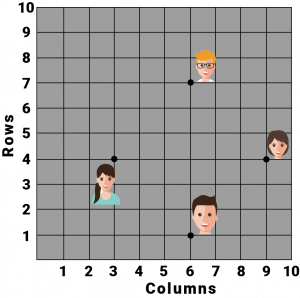
Answer: It can be observed that \(A (3, 4),\space B (6, 7),\space C (9, 4)\) and D \((6, 1)\) are the positions of these \(4\) friends.
\(AB=\sqrt{(3-6)^2+(4-7)^2 }=\sqrt{(-3)^2+(-3)^2 }=\sqrt{9+9}=\sqrt{18}=3\sqrt2\)
\(BC=\sqrt{(6-9)^2+(7-4)^2 }=\sqrt{(-3)^2+(3)^2 }=\sqrt{9+9}=\sqrt{18}=3\sqrt2\)
\(CB=\sqrt{(9-6)^2+(4-1)^2 }=\sqrt{(3)^2+(3)^2 }=\sqrt{9+9}=\sqrt{18}=3\sqrt2\)
\(AD=\sqrt{(3-6)^2+(4+1)^2 }=\sqrt{(-3)^2+(3)^2}\)
Diagonal \(AC=\sqrt{(3-9^2+(4-4)^2 }=\sqrt{(-6)^2+0^2 }=6\)
Diagonal \(BD=\sqrt{(6-6)^2+(7-1)^2 }=\sqrt{0^2+(6)^2=0}\)
It can be observed that all sides of this quadrilateral
\(ABCD\) are of the same length and also the diagonals are of the same length.
Therefore, \(ABCD\) is a square and hence.
Question 6: Name the type of quadrilateral formed, if any, by the following points, and give reasons for your answer:
(i) \((− 1, − 2), (1, 0), (− 1, 2), (− 3, 0)\)
(ii) \((− 3, 5), (3, 1), (0, 3), (− 1, − 4)\)
(iii) \((4, 5), (7, 6), (4, 3), (1, 2)\)
Answer:
(i) Let the points \((−1, −2), (1, 0), (−1, 2)\) and \((−3, 0)\) be representing the vertices \(A, B, C\) and \(D\) of the given quadrilateral respectively.
\(∴AB=\sqrt{(-1-1)^2+(-2-0)^2 }\)
\(=\sqrt{(-2)^2+(-2)^2 }\)
\(=\sqrt{4+4}=\sqrt{8}=2\sqrt2\)
\(BC=\sqrt{(-1-(-1))^2+(0-2)^2 }\)
\(=\sqrt{(2)^2+(-2)^2 }\)
\(=\sqrt{4+4}=\sqrt8=2\sqrt2\)
\(CD=\sqrt{(-1-(-3))^2+(2-0)^2}\)
\(=\sqrt{(2)^2+(2)^2 }\)
\(=\sqrt{4+4}=\sqrt8=2\sqrt2\)
\(AD=\sqrt{(-1-(-3))^2+(-2-0)^2}\)
\(=\sqrt{(2)^2+(-2)^2}\)
\(=\sqrt{4+4}=\sqrt8=2\sqrt2\)
Diagonal \(AC=\sqrt{(-1)-(-1))^2+(-2-2)^2 }\) \(=\sqrt{0^2+(-4)^2}\) \(=\sqrt{16}=4\)
Diagonal \(BD=\sqrt{(1-(-3))^2+(0-0)^2 }\) \(=\sqrt{(4)^2+0^2}\) \(=\sqrt{16}=4\)
It can be observed that all sides of this quadrilateral are of the same length and also, the diagonals are of the same length. Therefore, the given points are the vertices of a square.
(ii) Let the points \((− 3, 5), (3, 1), (0, 3)\) and \((−1, −4)\) be representing the vertices \(A, B, C\) and \(D\) of the given quadrilateral respectively.
\(AB=\sqrt{(-3-3)^2+(5-1)^2 }\)
\(=\sqrt{(-6)^2+(4)^2}\)
\(=\sqrt{36+16}=\sqrt{52}=2\sqrt{13}\)
\(BC=\sqrt{(3-1)^0+(5-1)^2}\)
\(=\sqrt{(3)^2+(-2)^2 }\)
\(=\sqrt{9+4}=\sqrt{13}\)
\(CD=\sqrt{(0-1(-1))^2+3(-(-4))^2}\)
\(=\sqrt{(1)^2+(7)^2}\) \(=\sqrt{1+49}=\sqrt{50}=5\sqrt2\)
\(AD=\sqrt{(-3-(-1))^2+(5-(-4))^2}\)
\(=\sqrt{(-2)^2+(9)^2}\) \(=\sqrt{4+81}=\sqrt{85}\)
It can be observed that all sides of this quadrilateral are of different lengths.
Therefore, it can be said that it is only a general quadrilateral, and not specific such as square, rectangle, etc.
(iii) Let the points \((4, 5), (7, 6), (4, 3)\) and \((1, 2)\) be representing the vertices \(A, B, C\) and \(D\) of the given quadrilateral respectively.
\(AB=\sqrt{(4-7)^2+(5-6)^2}\) \(=\sqrt{(-3)^2+(-1)^2}\) \(=\sqrt{9+1}=\sqrt{10}\)
\(BC=\sqrt{(7-4)^2+(6-3)^2}\) \(=\sqrt{(3)^2+(3)^2}\) \(=\sqrt{9+9}=\sqrt{18}\)
\(CD=\sqrt{(4-1)^2 (3-2)^2}\) \(=\sqrt{(3)^2+(1)^2}\) \(=\sqrt{9+1}=\sqrt{10}\)
\(AD=\sqrt{(4-1)^2+(5-2)^2}\) \(=\sqrt{(3)^2+(3)^2}\) \(=\sqrt{9+9}=\sqrt{18}\)
Diagonal \(AC=\sqrt{(4-4)^2+(5-3)^2}\)
\(=\sqrt{(0)62+(2)^2}\)
\(=\sqrt{0+4}=2\)
Diagonal \(CD=\sqrt{(7-1)^2+(6-2)^2}\)
\(=\sqrt{(6)^2+(4)^2}\) \(=\sqrt{26+16}\)
\(=\sqrt{52}=13\sqrt2\)
It can be observed that opposite sides of this quadrilateral are of the same length. However, the diagonals are of different lengths. Therefore, the given points are the vertices of a parallelogram.
Question 7: Find the point on the \(x-axis\) which is equidistant from \((2,-5)\) and \((-2,9)\).
Answer: We have to find a point on \(x-axis\). Therefore, its \(y-\) coordinate will be \(0\).
Let the point on \(x-axis\) be ((x,0)\).
Distance between \((x,0)\) and\((2,-5)=\sqrt{(x-2)^2+(0-(-5))^2}=\sqrt{(x-2)^2+(5)^2}\)
Distance between \((x,0)\) and \((-2,9)=\sqrt{(x-(-2))^2+0-(-0))^2}\)
\(=\sqrt{(x+2)^2+(9)^2}\)
By the given condition, these distance are equal in mesure.
\(\sqrt{(x-2)^2+(5)^2}=\sqrt{(x+2)^2+(9)^2}\)
\((x-2)^2+25=(x+2^2+81\)
\(x^2+4-4x+25=x^2+4+4x+81\)
\(8x=25-81\)
\(8x=-56\)
\(x=-7\)
Therefore, the point is \((− 7, 0)\).
Question 8: Find the values of y for which the distance between the points \(P (2, − 3)\) and \(Q (10, y)\) is \(10\) units.
Answer: It is given that the distance between \((2, −3)\) and \((10, y)\) is \(10\).
Therefore, \(\sqrt{(2-10)^2+(-3-y)^2}=10\)
\(\sqrt{(-8)^2+(3+y)^2}=10\)
\(64+(y+3)^2=100\)
\((y+3)^2=36\)
\(y+3=±6\)
\(y+3=6\) or \(y+3=-6\)
Therefore, \(y=3\) or \(-9\)
Question 9: If \(Q (0, 1)\) is equidistant from \(P (5, − 3)\) and \(R (x, 6)\), find the values of \(x\). Also find the distance \(QR\) and \(PR\).
Answer:
\(PQ=QR\)
\(\sqrt{(5-0)^2+(-3-1)^2}\) \(=\sqrt{(0-x^2+(1-6)^2}\)
\(\sqrt{(5)^2+(-4)^2}\) \(=\sqrt{(-x)^2+(5-)^2}\)
\(\sqrt{25+16}=\sqrt{x^2+25}\)
\(41=x^2=25\)
\(16=x^2\)
\(x=±4\)
Therefore, point \(R\) is \((4, 6)\) or \((-4, 6)\)
When point \(R\) is \((4, 6)\)
\(PR=\sqrt{(5-4)^2+(-3-6)^2}\) \(=\sqrt{1^2+(-9)^2}\) \(=\sqrt{1+81}=\sqrt{82}\)
\(QR=\sqrt{(0-4)^2+(1-6)^2}\) \(=\sqrt{(-4)^2+(-5)^2}\) \(=\sqrt{16+25}=\sqrt{41}\)
When point \(R\) is \((-4,6)\)
\(PR=\sqrt{(5-(-4))^2+(-3-6)^2}\) \(=\sqrt{(9)^2+(-9)^2}\) \(=\sqrt{81+91}=9\sqrt2\)
\(QR=\sqrt{(0-(-4))^2+(1-6)^2}\) \(=\sqrt{(4)^2+(-5)^2}\) \(=\sqrt{16+25}=\sqrt{41}\)
Question 10: Find a relation between \(x\) and \(y\) such that the point \((x, y)\) is equidistant from the point \((3, 6)\) and \((− 3, 4)\).
Answer: Point \((x, y)\) is equidistant from \((3, 6)\) and \((-3, 4)\).
\(∴\sqrt{(x-3)^2+(y-6)^2}\) \(=\sqrt{(x-(-3))^2+(y-4)^2}\)
\(\sqrt{(x-3)^2+(y-6)^2}\) \(=\sqrt{(x+3)^2+(y-4)^2}\)
\((x-3)^2+(y-6)^2=(x+3)^2+(y-4)^2\)
\(x^2+9-6x+y^2+36-12y=x^2+9+6x+y^2+16-8y\)
\(36-16=6x+6x+12y-8y\)
\(20=12x+4y\)
\(3x+y=5\)
\(3x+y-5=0\)
Exercise 7.2
Question 1: Find the coordinates of the point which divides the join of \((− 1, 7)\) and \((4, − 3)\) in the ratio \(2:3\).
Answer:
Let \(P(x, y)\) be the required point. Using the section formula, we obtain
\(x=\frac{2\times4+3\times(-1)}{2+3}=\frac{8-3}{5}=\frac{5}{5}=1\)
\(y=\frac{2\times(-3)+3\times7}{2+3}=\frac{(-6+21}{5}=\frac{15}{5}=3\)
Therefore, the point \((1,3)\).
Question 2: Find the coordinates of the points of trisection of the line segment joining \((4, − 1)\) and \((− 2, − 3)\).
Answer:

Let \(P (x_1, y_1)\) and \(Q (x_2, y_2)\) are the points of trisection of the line segment joining the given points i.e., \(AP = PQ = QB\)
Therefore, point \(P\) divides \(AB\) internally in the ratio \(1:2\).
\(x_1=\frac{1\times(-2)+2\times4}{1+2}\), \(y_1=\frac{1\times(-3)+2\times(-1)}{1+2}\)
\(x_1=\frac{-2+8}{3}=\frac{6}{3}=2\), \(y_1=\frac{-3-2}{3}=-\frac{5}{3}\)
Therefore, \(P(x_1,y_1)=(22,-\frac{5}{3})\)
Point \(Q\) divides \(AB\) internally in the ration \(2:1\).
\(x_2=\frac{2\times(-2)+1\times4}{2+1}\), \(y_2=\frac{2\times(-3)+1\times(-1)}{2+1}\)
\(x_2=\frac{-4+4=0}{3}\), \(y_2=\frac{-6-1}{3}=-\frac{7}{3}\)
\(Q(x_2,y_2)=(0,-\frac{7}{3})\)
Question 3: To conduct Sports Day activities, in your rectangular shaped school ground \(ABCD\), lines have been drawn with chalk powder at a distance of \(1\) m each. \(100\) flower pots have been placed at a distance of \(1\) m from each other along \(AD\), as shown in the following figure. Niharika runs \(\frac{1}{4}\) th the distance \(AD\) on the 2nd line and posts a green flag. Preet runs \(\frac{1}{5}\) th the distance \(AD\) on the eighth line and posts a red flag. What is the distance between both the flags? If Rashmi has to post a blue flag exactly halfway between the line segment joining the two flags, where should she post her flag?
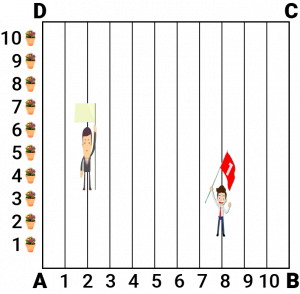
Answer: It can be observed that Niharika posted the green flag at \(\frac{1}{4}\) of the distance \(AD\) i.e., \((\frac{1}{4}×100),=25\space m\) from the starting point of 2nd line. Therefore, the coordinates of
this point \(G\) is \((2, 25)\).
Similarly, Preet posted red flag at \(\frac{1}{5}\) of the distance \(AD\) i.e., \((\frac{1}{5}×100)m=20\space m\) from the starting point of 8th line.
Therefore, the coordinates of this point \(R\) are \((8, 20)\).
Distance between these flags by using distance formula \(= GR\)
\(\sqrt{(8-2)^2+(25-20)^2}=\sqrt{36+25}=\sqrt{61}m\)
The point at which Rashmi should post her blue flag is the mid-point of the line joining these points.
Let this point be \(A (x, y)\).
\(x=\frac{2+8}{2}\), \(y=\frac{25+20}{2}\)
\(x=\frac{10}{2}=5,\space y=\frac{45}{2}=\frac{22}{5}\)
Hence, \(A(x,y)=(5,22.5)\)
Therefore, Rashmi should post her blue flag at \(22.5\space m\) on 5th line.
Question 4: Find the ratio in which the line segment joining the points \((− 3, 10)\) and \((6, − 8)\) is divided by \((− 1, 6)\).
Answer: Let the ratio in which the line segment joining \((−3, 10)\) and \((6, −8)\) is divided by point \((−1, 6)\) be \(k : 1\).
Therefore, \(-1=\frac{6k-3}{k+1}\)
\(-k-1=6l-3\)
\(7k=2\)
\(k=\frac{2}{7}\)
Therefore, there required ration is \(2:7\).
Question 5: Find the ratio in which the line segment joining \(A (1, − 5)\) and \(B (− 4, 5)\) is divided by the x-axis. Also find the coordinates of the point of division.
Answer: Let the ratio in which the line segment joining \(A (1, -5)\) and \(B (-4, 5)\) is divided by \(x-\)axis be \(k:1\)
Therefore, the coordinates of the point of division is \((\frac{-4k+1}{k+1},\frac{5k-5}{k+1})\)
We know that \(y-\)coordinate of any point on \(x-\)axis is \(0\).
\(∴\frac{5k-5}{k+1}=0\)
\(k=1\)
Therefore, \(x-\)axis divides it in the ration \(1:1\).
Division point \(=(\frac{-4(1)+1}{1+1},\frac{5(1)-5}{1+1})=(\frac{-4+1}{2},\frac{5-5}{2})=(\frac{-3}{2},0)\)
Question 6: If \((1, 2), (4, y), (x, 6)\) and \((3, 5)\) are the vertices of a parallelogram taken in order, find \(x\) and \(y\).
Answer:

Let \((1, 2), (4, y), (x, 6)\) and \((3, 5)\) are the coordinates of \(A, B, C, D\) vertices of a parallelogram \(ABCD\). Intersection point \(O\) of diagonal \(AC\) and \(BD\) also divides these diagonals.
Therefore, \(O\) is the mid-point of \(AC\) and \(BD\).
If \(O\) is the mid-point of \(AC\), then the coordinates of \(O\) are
\((\frac{1+x}{2},\frac{2+6}{2})⇒(\frac{x+1}{2},4)\)
If \(O\) is the mid-point of \(BD\), then the coordinates of \(O\) are
\((\frac{4+3}{2},\frac{5+y}{2})⇒(\frac{7}{2},\frac{5+y}{2})\)
Since both the coordinates are of the same point \(O\).
\(∴\frac{x+1}{2}=\frac{7}{2}\) and \(4=\frac{5+y}{2}\)
\(⇒x+1=7\) and \(5+y=8\)
\(⇒x=6\) and \(y=3\)
Question 7: Find the coordinates of a point \(A\) , where \(AB\) is the diameter of circle whose centre is \((2, − 3)\) and \(B\) is \((1, 4)\)
Answer: Let the coordinates of point \(A\) be \((x, y)\).
Mid-point of \(AB\) is \((2, −3)\) which is the center of the circle.
\(∴(2,-3)=(\frac{x+1}{2},\frac{y+4}{2})\)
\(⇒\frac{x+1}{2}=2\) and \(\frac{y+4}{2}=-3\)
\(⇒x+1=4\) and \(y+4=-6\)
\(⇒x=-3\) and \(y=-10\)
Therefore, the coordinates of \(A\) are \((3,-10)\).
Question 8: If \(A\) and \(B\) are \((− 2, − 2)\) and \((2, − 4)\), respectively, find the coordinates of \(P\) such that \(AP=\frac{3}{7}AB\) and \(P\) lies on the line segment \(AB\).
Answer:

The coordinates of point \(A\) and \(B\) are \((−2, −2)\) and \((2, −4)\) respectively.
Therefore \(AP=\frac{3}{7}AB\)
Therefore, \(AP:PB=3:4\)
Point \(P\) divides the line segment \(AB\) in the ration \(2:4\).
Coordinates of \(P=(\frac{3\times2+4\times(-2)}{3+4},\frac{3\times(-4)+4\times(-2)}{3\times4})\)
\(=(\frac{6-8}{7},\frac{-12-8}{7})\)
\(=(-\frac{2}{7},\frac{20}{7})\)
Question 9: Find the coordinates of the points which divide the line segment joining \(A (− 2, 2)\) and \(B (2, 8)\) into four equal parts.
Answer:

From the figure, it can be observed that points \(P, Q, R\) are dividing the line segment in a ratio \(1:3, 1:1, 3:1\) respectively.
Coordinate of \(P=(\frac{1\times2+3\times(-2)}{1+3},\frac{1\times8+3\times2}{1+3})\)
\(=(-1,\frac{7}{2})\)
Coordinates of \(Q=(\frac{2+(-2)}{2},\frac{2+8}{2})\)
\(=(0,5)\)
Coordinates of \(R=(\frac{3\times2+1\times(-2)}{3+1},\frac{3\times+1\times2}{3+1})\)
\(=(1,\frac{13}{2})\)
Question 10: Find the area of a rhombus if its vertices are \((3, 0), (4, 5), (- 1, 4)\) and \((- 2, -1)\) taken in order. [Hint: Area of a rhombus \(= \frac{1}{2}\) (product of its diagonals)]
Answer:

Let \((3, 0), (4, 5), (−1, 4)\) and \((−2, −1) \)are the vertices \(A, B, C, D\) of a rhombus \(ABCD\).
Length of diognal \(AC=\sqrt{[3-(-1)]^2+(-04)^2}\)
\(=\sqrt{16+16}=4\sqrt2\)
Length of diaagonal \(BD=\sqrt{[4-(-2)]^2+[5-1-1(1)]^2}\)
\(=\sqrt{36+36}=6\sqrt2\)
Therefore, area of rhombus \(ABCD=\frac{1}{2}\times4\sqrt2\times6\sqrt2\)
\(=24\) square units.
xercise 7.3
Question 1: Find the area of the triangle whose vertices are:
(i) \((2, 3), (− 1, 0), (2, − 4)\)
(ii) \((− 5, − 1), (3, − 5), (5, 2)\)
Answer:
(i) Area of a triangle is given by
Area of a triangle is given by
Area of a traingle
\(=\frac{1}{2}[x_1 (y_2-y_3 )+x_2 (y_3-y_1 )+x_3 (y_1-y_2 )]\)
Area of the given triangle
\(=\frac{1}{2} [2(0-(-4))+(-1)-(3)+2(3-0)]\)
\(=\frac{1}{2}(8+7+6)\)
\(=\frac{21}{2}\) square units.
(ii) Area of the given triangle
\(=\frac{1}{2} [(-5){(-5)-(2)}+3(2-(-1))+5{-1(-5)}]\)
\(=\frac{1}{2}(35+9+20)\)
\(=32\) square units.
Question 2: In each of the following find the value of \(‘k’\), for which the points are collinear.
(i) \((7, − 2), (5, 1), (3, − k)\)
(ii) \((8, 1), (k, − 4), (2, − 5)\)
Answer:
(i) For collinear points, area of triangle formed by them is zero.
Therefore, for points \((7, −2) (5, 1)\) and \((3, k)\) area \(= 0\)
\(\frac{1}{2}[7(1-k)+5\lbrace k-(-2)\rbrace+3(-2)-1]=0\)
\(7-7k+5k+10-9=0\)
\(-2k+8=0\)
\(k=4\)
(ii) For collinear points, area of triangle formed by them is zero.
Therefore, for points \((8, 1), (k, −4)\) and \((2, −5)\) area \(= 0 \)
\(\frac{1}{2}[8\lbrace-4-(-5)\rbrace+k\lbrace(-5)-(1)\rbrace+2\lbrace1-(-4)\rbrace]=0\)
\(8-6k+10=0\)
\(6k=18\)
\(k=3\)
Question 3: Find the area of the triangle formed by joining the mid-points of the sides of the triangle whose vertices are \((0, − 1), (2, 1)\) and \((0, 3)\). Find the ratio of this area to the area of the given triangle.
Answer:

Let the vertices of the triangle be \(A (0, −1), B (2, 1), C (0, 3)\).
Let \(D, E, F\) be the mid-points of the sides of this triangle. Coordinates of \(D, E\) and \(F\) are given by
\(D=(\frac{0+2}{2},\frac{-1+1}{2})=(1,0)\)
\(E=(\frac{0+0}{2},\frac{3-1}{2})=(0,1)\)
\(F=(\frac{2+0}{2},\frac{1+3}{2})=(1,2)\)
Area of a triangle\(=\frac{1}{2}[x_1 (y_2-y_3 )+x_2 (y_3-y_1 )+x_3 (y_1-y_2 )]\)
Area of Area of \(∆DEF=\frac{1}{2}[1(2-1)+1(1-0)+0(0-2)]\)
\(=\frac{1}{2} (1+1)=1\) square units
Area of \(∆ABC=\frac{1}{2} [0(1-3)+2(3-(-1))+0(-1-1)]\)
\(=\frac{1}{2}(8)=4\) square units.
Therefore, required ration \(=1:4\)
Question 4: Find the area of the quadrilateral whose vertices, taken in order, are \((− 4, − 2), (− 3, − 5), (3, − 2)\) and \((2, 3)\)
Answer:

Let the vertices of the quadrilateral be \(A (−4, −2), B (−3, −5), C (3, −2)\) and \(D (2, 3)\).
Join \(AC\) to form two triangles \(ΔABC\) and \(ΔACD\).
Area of triangle \(=\frac{1}{2}[x_1(y_2-y_3)+x_2(y_3-y_1)+x_3(y_1-y_2)]\)
Area of
\(\Delta ABC=\frac{1}{2}[(-4)((-5)-(-2))+(-3)((-2)-(-2))+3((-2)-(-5))]\)
\(=\frac{1}{2}(12+0+9)=\frac{21}{2}\) square units.
Area of \(∆ACD=\frac{1}{2} [(-4)\lbrace(-2)-(3)\rbrace+3\lbrace(3)-(-2)\rbrace+2\lbrace(-2)-(-2)\rbrace]\)
\(=\frac{1}{2}(20+15+0)=\frac{35}{2}\) square units.
Area of \(□ABCD=\) Area of \(∆ABC+Area of ∆ACD\)
\(=(\frac{21}{2}+\frac{35}{2})\) square units \(=28\) square units.
Question 5: You have studied in Class IX that a median of a triangle divides it into two triangles of equal areas. Verify this result for \(ΔABC\) whose vertices are \(A(4,− 6), B(3,− 2)\) and \(C(5,2)\)
Answer:

Let the vertices of the triangle be \(A (4, -6), B (3, -2)\) and \(C (5, 2)\)
Let \(D\) be the mid-point of side \(BC\) of \(ΔABC\). Therefore, \(AD\) is the median in \(ΔABC\).
Coordinates of point \(D=(\frac{3+5}{2},\frac{-2+2}{2})=(4,0)\)
Area of triangle\(=\frac{1}{2}\){\(x_1 (y_2-y_3 )+x_2 (y_3-y_1 )+x_3 (y_1-y_2 )\)}
Area of \(∆ABD=\frac{1}{2}[(4)\lbrace(-2)-(0)\rbrace+\lbrace(0)-(-6)\rbrace+(4)\lbrace(-6)-(-2)\rbrace]\)
\(=\frac{1}{2} (-8+18-16)=-3\) square units.
However, area cannot be negative. Therefore, area of \(ΔABD\) is \(3\) square units.
Area triangle \\(=\frac{1}{2}[x_1 (y_2-y_3 )+x_2 (y_3-y_1 )+x_3 (y_1-y_2 )]\)
Area of \(∆ABD=\frac{1}{2}[(4)\lbrace0-(2)\rbrace+(4)\lbrace(2)-(-6)\rbrace+(5)\lbrace-6)-(0)\rbrace]\)
\(=\frac{1}{2}(-8+32-30)=-3\) square units.
However, area cannot be negative.
Therefore, area of \(ΔADC\) is \(3\) square units.
Clearly, median \(AD\) has divided \(ΔABC\) in two triangles of equal areas.
Exercise 7.4
Question 1: Determine the ratio in which the line \(2x + y − 4 = 0\) divides the line segment joining the points \(A(2, − 2)\) and \(B(3, 7)\)
Answer: Let the given line divide the line segment joining the points \(A(2, −2)\) and \(B(3, 7)\) in a ratio \(k : 1\).
Coordinates of the point of division \(=(\frac{3k+2}{k+1},\frac{7k-2}{k+1})\)
This point also lies on \(2x+y-4=0\)
\(∴2(\frac{3k+2}{k+1})+(\frac{7k-2}{k+1})-4=0\)
\(⇒\frac{6k+4+7k-2-4k-4}{k+1}=0\)
\(⇒9k-2=0\)
\(⇒k=\frac{2}{9}\)
Therefore, the ratio in which the line \(2x + y − 4 = 0\) divides the line segment joining the points \(A(2, −2)\) and \(B(3, 7) is 2:9\).
Question 2: Find a relation between \(x\) and \(y\) if the points \((x, y), (1, 2)\) and \((7, 0) \)are collinear.
Answer: If the given points are collinear, then the area of triangle formed by these points will be \(0\).
Area of a tringle \(=\frac{1}{2}[x_1(y_2-y_3)+x_2(y_3-y_1)+x_3(y_1-y_2)]\)
Area \(=\frac{1}{2}[x(2-9)+1(0-y)+7(y-2)]\)
\(0=\frac{1}{2}(2x-y+7y-14)\)
\(0=\frac{1}{2}(3x+6y-14)\)
\(2x=6y-14=0\)
\(x+3y-7=0\)
This is the required relation between \(x\) and \(y\).
Question 3: Find the centre of a circle passing through the points \((6, − 6),\space (3, − 7)\) and \((3, 3)\).
Answer: Let \(O\space (x, y)\) be the centre of the circle.
And let the points \((6, −6),\space (3, −7)\) and \((3, 3)\) be representing the points \(A, B\) and \(C\) on the circumference of the circle.
\(∴OA=\sqrt{(x-6)^2+(y+6)^2}\)
\(OB=\sqrt{(x-3)^2+(y+7)^2}\)
\(OC=\sqrt{(x-3)^2+(y-3)^2}\)
However, \(OA=OB\) (Radii of the same circle)
\(⇒\sqrt{(x-6)^2+(y+6)^2}\) \(=\sqrt{(x-3)^2+(y+7)^2}\)
\(⇒x^2+36-12x+y^2+36+12y\) \(=x^2+9-6x+y^2+49+14y\)
\(⇒-6x-2y+14=0\)
\(⇒3x+y=7\) ….(1)
Similarly, \(OA=OC\) (Radii of the same circle)
\(⇒\sqrt{(x-6)^2+(y+6)^2}\) \(=\sqrt{(x-3)^2+(y-3)^2}\)
\( ⇒ x^2+36-12x+y^2+36+12y\) \(=x^2+9-6x+y^2+9-6y\)
\(⇒-6x+18y+54=0\)
\(⇒-3x+9y=-27\) …(ii)
On adding equation (1) and (2), we obtain
\(10y = −20\)
\(y = −2\)
From equation (1), we obtain
\(3x − 2 = 7\)
\(3x = 9\)
\(x = 3\)
Therefore, the centre of the circle is \((3, −2).\)
Question 4: The two opposite vertices of a square are \((− 1, 2)\) and \((3, 2)\). Find the coordinates of the other two vertices.
Answer:

Let \(ABCD\) be a square having \((−1, 2)\) and \((3, 2)\) as vertices \(A\) and \(C\) respectively.
Let \((x, y), (x1, y1)\) be the coordinate of vertex \(B\) and \(D\) respectively.
We know that the sides of a square are equal to each other.
\(∴ AB = BC\)
\(⇒\sqrt{(x+1)^2+(y-2)^2}\) \(=\sqrt{(x-3)^2+(y-2)^2}\)
\(⇒x^2+2x+1+y^2-4y+4\) \(=x^2+9-6x+y^2+4-4y\)
\(⇒8x=8\)
\(⇒x=1\)
We know that in a square, all interior angles are of \(90^0\).
In \(ΔABC\),
\(AB^2 + BC^2 = AC^2\)
\(⇒(\sqrt{(1+1)^2+(y-2)^2 })^2+(\sqrt{(1-3)^2+(y-2)^2 })\) \(=(\sqrt{(3+1)^2+(2-2)^2 })^2\)
\(⇒ 4 + y^2 + 4 − 4y + 4 + y^2 − 4y + 4 =16\)
\(⇒ 2y^2 + 16 − 8 y =16\)
\(⇒ 2y^ − 8 y = 0\)
\(⇒ y (y − 4) = 0\)
\(⇒ y = 0\) or \(4\)
We know that in a square, the diagonals are of equal length and bisect each other at \(90^0\).
Let \(O\) be the mid-point of \(AC\). Therefore, it will also be the mid-point of \(BD\).
\((\frac{1+x_1}{2},\frac{y=y_1}{2})=(1,2)\)
\(\frac{1+x_1}{2}=1\)
\(1+x_1=2\)
\(x_1=1\)
And \(\frac{y+y_1}{2}=2\)
\(⇒y+y_1\)
\(4\) if \(y=0\)
\(y_1=4\)
If \(y=4\)
\(y_1=0\)
Therefore, the required coordinates are \((1, 0)\) and \((1, 4)\).
Question 5: The class \(X\) students of a secondary school in Krishinagar have been allotted a rectangular plot of land for their gardening activity. Saplings of Gulmohar are planted on the boundary at a distance of \(1\space m\) from each other. There is a triangular grassy lawn in the plot as shown in the following figure. The students are to sow seeds of flowering plants on the remaining area of the plot.
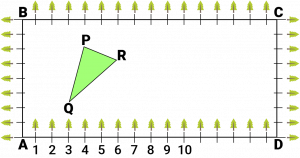
(i) Taking A as origin, find the coordinates of the vertices of the triangle.
(ii) What will be the coordinates of the vertices of PQR if C is the origin? Also calculate the areas of the triangles in these cases. What do you observe?
Answer:
(i) Taking \(A\) as origin, we will take \(AD\) as \(x\)-axis and \(AB\) as \(y\)-axis. It can be observed that the coordinates of point \(P, Q\) and \(R\) are \((4, 6), (3, 2)\) and \((6, 5)\) respectively.
Area of triangle \(PQR=\frac{1}{2} [x_1 (y_2-y_3 )+x_2 (y_3-y_1 )+x_3 (y_1-y_2 )]\)
\(=\frac{1}{2}[4(2-5)+3(5-6)+6(6-2)]\)
\(=\frac{1}{2}[-12-3+24]\)
\(=\frac{9}{2}\) square units.
(ii) Taking \(C\) as origin, \(CB\) as \(x\)-axis, and \(CD\) as \(y\)-axis, the coordinates of vertices \(P, Q\) and \(R\) are \((12, 2), (13, 6)\) and \((10, 3)\) respectively.
Area of triangle \(PQR=\frac{1}{2} [x_1 (y_2-y_3 )+x_2 (y_3-y_1 )+x_3 (y_1+y_2 )]\)
\(=\frac{1}{2}[12(6-3)+13(3-2)+10(2-6)] \)
\(=\frac{1}{2}[36+13-40]\)
\(=\frac{9}{2}\) square units.
It can be observed that the area of the triangle is same in both the cases.
Question 6: The vertices of a \(ΔABC\) are \(A (4, 6), B (1, 5)\) and \(C (7, 2)\). A line is drawn to intersect sides \(AB\) and \(AC\) at \(D\) and \(E\) respectively, such that \(\frac{AD}{AB}=\frac{AE}{AC}=\frac{1}{4}\). Calculate the area of the \(ΔADE\) and compare it with the area of \(ΔABC\). (Recall Converse of basic proportionality theorem and Theorem \(6.6\) related to ratio of areas of two similar triangles)

Answer:
Given that, \(\frac{AD}{AB}=\frac{AE}{AC}=\frac{1}{4}\)
\(\frac{AD}{AD+DB}=\frac{AE}{AE+EC}=\frac{1}{3}\)
Therefore, \(D\) and \(E\) are two points on side \(AB\) and \(AC\) respectively such that they divide side \(AB\) and \(AC\) in a ratio of \(1:3\).
Coordinates of Point \(D=(\frac{1\times+3\times4}{1+3},\frac{1\times5+3\times6}{1+3}\)
\(=(\frac{13}{4},\frac{23}{4})\)
Coordinates of point \(E=(\frac{1\times7\times3\times4}{1+3},\frac{1\times2+3\times6}{1+3})\)
\(=(\frac{19}{4},\frac{20}{4})\)
Area of a triangle \(=\frac{1}{2}[x_1 (y_2-y_3 )+x_2 (y_3-y_1 )+x_3 (y_1-y_2 )]\)
Area of a triangle \(=\frac{1}{2} [4(\frac{23}{4}-\frac{20}{4})+\frac{13}{4}(\frac{20}{4}-6)+\frac{19}{4} (6-\frac{23}{4})]\)
\(=\frac{1}{2}[12-4+7]=\frac{15}{2}\) square units.
Clearly, the ratio between the areas of \(ΔADE\) and \(ΔABC\) is \(1:16\).
Alternatively,
We know that if a line segment in a triangle divides its two sides in the same ratio, then the line segment is parallel to the third side of the triangle. These two triangles so formed (here \(ΔADE\) and \(ΔABC\)) will be similar to each other.
Hence, the ratio between the areas of these two triangles will be the square of the ratio between the sides of these two triangles.
Therefore, ratio between the areas of \(ΔADE\) and \(ΔABC\) \(=(\frac{1}{4})^2=\frac{1}{6}\)
Question 7: Let \(A (4, 2),\space B (6, 5)\) and \(C (1, 4)\) be the vertices of \(ΔABC\).
(i) The median from \(A\) meets \(BC\) at \(D\) . Find the coordinates of point \(D\).
(ii) Find the coordinates of the point \(P\) on \(AD\) such that \(AP: PD = 2:1\)
(iii) Find the coordinates of point \(Q\) and \(R\) on medians \(BE\) and \(CF\) respectively such that \(BQ: QE = 2:1\) and \(CR: RF = 2:1\).
(iv) What do you observe?
(v) If \(A(x_1, y_1),\space B(x_2, y_2)\) and \(C(x_3, y_3)\) are the vertices of \(ΔABC\), find the coordinates of the centroid of the triangle.
Answer:

(i) Median \(AD\) of the triangle will devide the side \(BC\) in two equal parts.
Therefore \(D\) is the mid-point of side \(BC\).
Coordinates of \(D=(\frac{6+1}{2},\frac{5+4}{2})=(\frac{7}{2},\frac{9}{2})\)
(ii) Point \(P\) divides the side \(AD\) in a ration \(2:1\)
Coordinates of \(P=(\frac{2\times\frac{7}{2}+1\times4}{2+1},\frac{2\times\frac{9}{2}+1\times2}{2+1})\) \(=(\frac{11}{3},\frac{11}{3})\)
(iii) Median \(BE\) of the triangle will divide the side \(AC\) in two equal parts.
Therefore, \(E\) is the mid-point of side \(AC\).
Coordinates of \(E=(\frac{4+1}{2},\frac{2+4}{2})=(\frac{5}{2},3)\)
Point \(Q\) divides the side \(BE\) in a ration \(2:1\)
Coordinated of \(Q=(\frac{2\times\frac{5}{2}+1\times6}{2+1},\frac{2\times3+1\times5}{2+1})\) \(=(\frac{11}{3},\frac{11}{3})\)
Median \(CF\) of the triangle will divide the side \(AB\) in two equal parts.
Therefore, \(F\) is the mid-point of side \(AB\).
Coordinates of \(F=(\frac{4+5}{2},\frac{2+5}{2})=(5,\frac{7}{2})\)
Point \(R\) divides the side \(CF\) in a ration \(2:1\)
Coordinates of \(R=(\frac{2\times5+1\times1}{2+1},\frac{2\times\frac{7}{2}+1\times4}{2+1})\) \(=(\frac{11}{3},\frac{11}{3})\)
(iv) It can be observed that the coordinates of point \(P, Q, R\) are the same.
Therefore, all these are representing the same point on the plane i.e., the centroid of the triangle.
(v) Consider a triangle, \(ΔABC\), having its vertices as \(A(x_1, y_1), B(x_2, y_2)\) and \(C(x_3,y_3)\).
Median \(AD\) of the triangle will divide the side \(BC\) in two equal parts. Therefore, \(D\) is the mid-point of side \(BC\).
Coordinates of \(D=(\frac{x_2+x_3}{2},\frac{y_2+y_3}{2})\)
Let the centroid of this triangle be \(0\).
Point \(O\) divides the side \(AD\) in a ratio \(2:1\).
Coordinates of \(0=(\frac{2\times\frac{x_2+x_3}{2}=1\times x_1}{2+1},\frac{2\times\frac{y_2+y_3}{2}+1\times y_1}{2+1})\)
\(=(\frac{x_1+x_2+x_3}{3},\frac{y_1+y_2+y_3}{3})\)
Question 8: \(ABCD\) is a rectangle formed by the points \(A (− 1, − 1),\space B (− 1, 4),\space C (5, 4)\) and \(D (5,− 1). P, Q, R\) and \(S\) are the mid-points of \(AB, BC, CD\) and \(DA\)respectively. Is the quadrilateral \(PQRS\) is a square? a rectangle? or a rhombus? Justify your answer.
Answer:
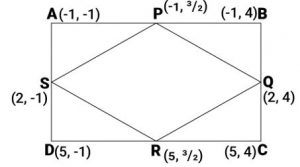
\(P\) is the mid-point of side \(AB\).
Therefore, the coordinates of \(P\) are \((\frac{-1-1}{2},-\frac{1+4}{2})=(-1,\frac{3}{2})\)
Similarly, the coordinates of \(Q,R\) and \(S\) are \((2,4),(5,\frac{3}{2})\) and \((2,-1)\) respectively
Length of \(PQ=\sqrt{(-1-1)^2+(\frac{3}{2}-4)^2}=\sqrt{9+\frac{25}{4}}=\sqrt{\frac{61}{4}}\)
Length of \(QR=\sqrt{(2-5)^2+(4-\frac{3}{2})6^2}=\sqrt{9+\frac{25}{4}}=\sqrt{\frac{61}{4}}\)
Length of \(RS=\sqrt{(5-1)^2+(\frac{3}{2}+1)^2}=\sqrt{9+\frac{25}{4}}=\sqrt{\frac{61}{4}}\)
Length of \(SP=\sqrt{(2+1)^2+(-1-\frac{3}{2})^2}=\sqrt{9+\frac{25}{4}}=\sqrt{\frac{61}{4}}\)
Length of \(PR=\sqrt{(-1-5)^2+(\frac{3}{2}-\frac{3}{2})^2}=6\)
Length of \(QS=\sqrt{(2-2)^2+(4+1)^2=5}\)
It can be observed that all sides of the given quadrilateral are of the same measure.
However, the diagonals are of different lengths.
Therefore, \(PQRS\) is a rhombus.
Study materials
- Refernce Books
- NCERT Solutions
- Syllabus
